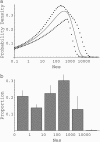The distribution of fitness effects of new deleterious amino acid mutations in humans
- PMID: 16547091
- PMCID: PMC1526495
- DOI: 10.1534/genetics.106.057570
The distribution of fitness effects of new deleterious amino acid mutations in humans
Abstract
The distribution of fitness effects of new mutations is a fundamental parameter in genetics. Here we present a new method by which the distribution can be estimated. The method is fairly robust to changes in population size and admixture, and it can be corrected for any residual effects if a model of the demography is available. We apply the method to extensively sampled single-nucleotide polymorphism data from humans and estimate the distribution of fitness effects for amino acid changing mutations. We show that a gamma distribution with a shape parameter of 0.23 provides a good fit to the data and we estimate that >50% of mutations are likely to have mild effects, such that they reduce fitness by between one one-thousandth and one-tenth. We also infer that <15% of new mutations are likely to have strongly deleterious effects. We estimate that on average a nonsynonymous mutation reduces fitness by a few percent and that the average strength of selection acting against a nonsynonymous polymorphism is approximately 9 x 10(-5). We argue that the relaxation of natural selection due to modern medicine and reduced variance in family size is not likely to lead to a rapid decline in genetic quality, but that it will be very difficult to locate most of the genes involved in complex genetic diseases.
Figures



References
-
- Andolfatto, P., 2005. Adaptive evolution of non-coding DNA in Drosophila. Nature 437: 1149–1152. - PubMed
-
- Bergman, C. M., and M. Kreitman, 2001. Analysis of conserved noncoding DNA in Drosophila reveals similar constraints in intergenic and intronic sequences. Genome Res 11: 1335–1345. - PubMed
-
- Cardon, L. R., and J. I. Bell, 2001. Association study designs for complex diseases. Nat. Rev. Genet. 2: 91–99. - PubMed
-
- Cargill, M., D. Altshuler, J. Ireland, P. Sklar, K. Ardlie et al., 1999. Characterization of single-nucleotide polymorphisms in coding regions of human genes. Nature Genetics 22: 231–238. - PubMed
Publication types
MeSH terms
Substances
LinkOut - more resources
Full Text Sources
Other Literature Sources

